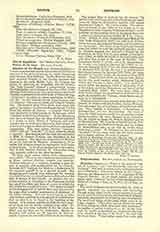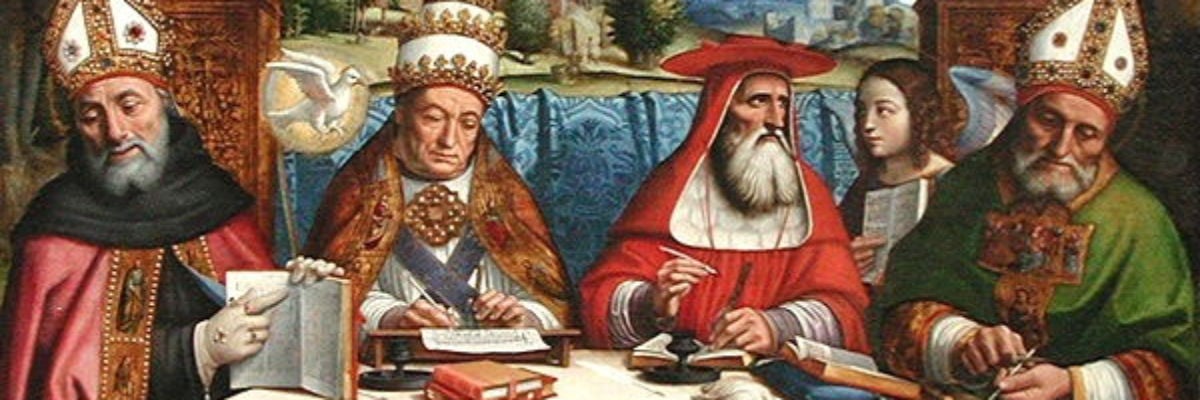

Doctors of the Church (Lat. Doctores Ecclesiae).—Certain ecclesiastical writers have received this title on account of the great advantage the whole Church has derived from their doctrine. In the Western Church four eminent Fathers of the Church attained this honor in the early Middle Ages: St. Gregory the Great, St. Ambrose, St. Augustine, and St. Jerome. The “four Doctors” became a commonplace among the Scholastics, and a decree of Boniface VIII (1298) ordering their feasts to be kept as doubles in the whole Church is contained in his sixth book of Decretals (cap. “Gloriosus”, de reliqu. et vener. sanctorum, in Sexto, III, 22). In the Eastern Church three Doctors were preeminent: Chrysostom, Basil, and Gregory Nazianzen. The feasts of these three saints were made obligatory throughout the Eastern Empire by Leo VI, the Wise, the deposer of Photius. A common feast was later instituted in their honor on January 30, called “the feast of the three Hierarchs”. In the Menaea for that day it is related that the three Doctors appeared in a dream to John, Bishop of Euchaitae, and commanded him to institute a festival in their honor, in order to put a stop to the rivalries of their votaries and panegyrists. This was under Alexius Comnenus (1081-1118; see “Acta SS.”, June 14, under St. Basil, c. xxxviii). But sermons for the feast are attributed in MSS. to Cosmas Vestitor, who flourished in the tenth century. The three are as common in Eastern art as the four are in Western. Durandus (i, 3) remarks that Doctors should be represented with books in their hands. In the West analogy led to the veneration of four Eastern Doctors, St. Athanasius being very properly added to the three hierarchs.
To these great names others have subsequently been added. The requisite conditions are enumerated as three: eminens doctrina, insignis vitoe sanctitas, Ecclesioe declaratio (i.e. eminent learning, a high degree of sanctity, and proclamation by the Church). Benedict XIV explains the third as a declaration by the supreme pontiff or by a general council. But though general councils have acclaimed the writings of certain Doctors, no council has actually conferred the title of Doctor of the Church. In practice the procedure consists in extending to the Universal Church the use of the Office and Mass of a saint in which the title of Doctor is applied to him. The decree is issued by the Congregation of Sacred Rites and approved by the pope, after a careful examination, if necessary, of the saint’s writings. It is not in any way an ex cathedra decision, nor does it even amount to a declaration that no error is to be found in the teaching of the Doctor. It is, indeed, well known that the very greatest of them are not wholly immune from error. No martyr has ever been included in the list, since the Office and the Mass are for Confessors. Hence, as Benedict XIV points out, St. Ignatius, St. Irenaeus, and St. Cyprian are not called Doctors of the Church.
The proper Mass of Doctors has the Introit “In medio”, borrowed from that of the Theologus par excellence, St. John the Evangelist, together with special prayers and Gospel. The Credo is said. The principal peculiarity of the Office is the antiphon to the Magnificat at both Vespers, “O Doctor optime”, and it is rather by this antiphon than by the special Mass that a saint is perceived to be a Doctor (S. R. C., September 7, 1754). In fact, St. John Damascene has a Mass of his own, while Athanasius, Basil, Leo, and Cyril of Jerusalem have not the Gospel of Doctors, and several have not the collect. The feasts of the four Latin Doctors were not added to until the sixteenth century, when St. Thomas Aquinas was declared a Doctor by the Dominican St. Pius V in his new edition of the Breviary (1568), in which the feasts of the four Greek Doctors were also raised to the rank of doubles. The Franciscan Sixtus V (1588) added St. Bonaventure. St. Anselm was added by Clement XI (1720), St. Isidore by Innocent XIII (1722), St. Peter Chrysologus by Benedict XIII (1729), St. Leo I (a well-deserved but belated honor) by Benedict XIV (1754), St. Peter Damian by Leo XII (1828), St. Bernard by Pius VIII (1830). Pius IX gave (1851) the honor to St. Hilary and to two more modern saints, Alphonsus Liguori (1871) and Francis de Sales (1877). Leo XIII promoted (1883) the Easterns, Cyril of Alexandria, Cyril of Jerusalem, and John Damascene, and last of all the Venerable Bede (1899). The same pope, when, in 1882, he introduced the simplification of double feasts, made an exception for Doctors, whose feasts are always to be transferred.
There are therefore now twenty-three Doctors of the Church, of whom seven are Eastern, sixteen Western. Two are popes, two are cardinals, all but five are bishops. They include a Dominican, a Franciscan, a Redemptorist, and five Benedictines. For some of these the Office had previously been granted to certain places or orders—St. Peter Damian to the Camaldolese, St. Isidore to Spain, St. Bede to England and to all Benedictines. St. Leander of Seville and St. Fulgentius are kept as Doctors in Spain, and the former by Benedictines also, as he was in earlier times claimed as a monk. St. Ildephonsus has the Introit “In medio” in the same order (for the same reason) and in Spain, without the rank of Doctor.
JOHN CHAPMAN.


